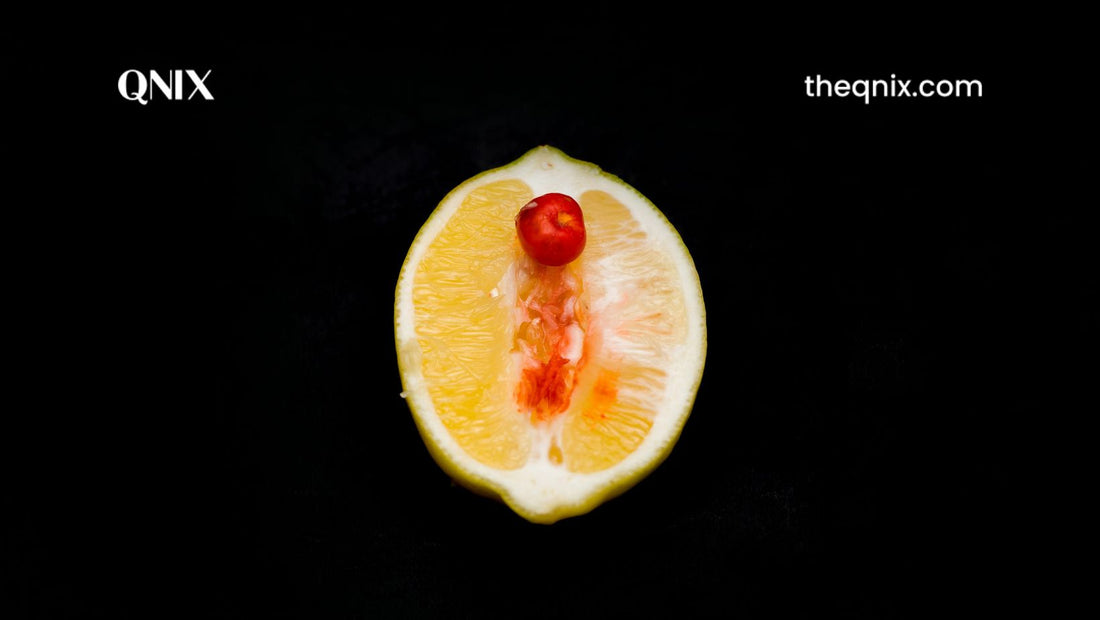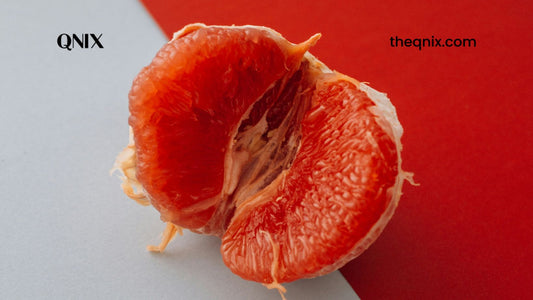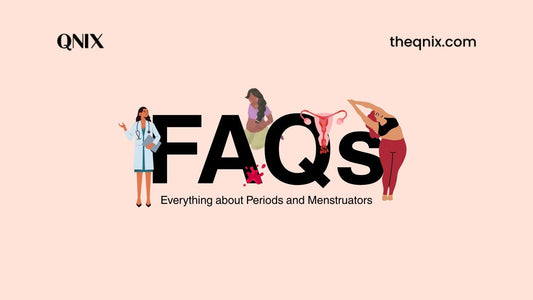Have you ever noticed a little bit of blood mid-cycle and wondered what’s going on?
This could be something called ovulation bleeding, and while it can be surprising, it’s not necessarily a cause for concern. Understanding the difference between what's normal and what’s not can help you better manage your cycle and know when to seek advice.
This guide will cover everything you need to know, from what causes ovulation bleeding to how to differentiate it from other types of bleeding.
Table of Contents:
- What Is Ovulation Bleeding?
- Signs and Symptoms of Ovulation Bleeding
- Causes of Ovulation Bleeding
- Ovulation Bleeding vs. Implantation Bleeding
- Ovulation Bleeding vs. Periods
- When Should You Take a Pregnancy Test?
- How to Manage Ovulation Bleeding Comfortably
- Stay Comfortable During Your Cycle with Qnix Period Underwear
- Frequently Asked Questions
What Is Ovulation Bleeding?
Ovulation bleeding is a light spotting that happens when your body releases an egg during the ovulation phase of your menstrual cycle. For some, it’s a sign their body is working as expected, while others may never experience it.
Ovulation typically occurs around the middle of your cycle, about 14 days before your next period, when a mature egg is released from the ovary. As estrogen levels peak and fall rapidly during this phase, it may cause a small amount of blood to appear.
While ovulation bleeding isn’t common, it is usually nothing to worry about.
Signs and Symptoms of Ovulation Bleeding
Spotting Color and Flow
Ovulation spotting typically appears as light pink or reddish-brown rather than the heavy flow you experience during your period. The flow is generally very light and lasts only a day or two, unlike the more consistent and heavier bleeding associated with menstruation.
Duration of Ovulation Bleeding
If you’re spotting due to ovulation, expect it to last anywhere from a few hours to 1-2 days. Anything longer than that might indicate something else, like hormonal imbalances or an early period.
Other Ovulation Symptoms
In addition to spotting, many women experience increased cervical mucus (which may be egg-white in consistency), mild cramping, and a slight increase in body temperature during ovulation. These signs can help confirm that the spotting is due to ovulation.
Also Read: White Discharge Before Period: Normal or a Sign of Health Issues?
Causes of Ovulation Bleeding
The primary cause of ovulation bleeding is hormonal changes. When your body gears up for ovulation, estrogen levels spike, then drop sharply after the egg is released, causing a minor disruption in your uterine lining. This sudden hormonal shift can lead to a small amount of blood being shed.
Hormonal Changes Leading to Ovulation Bleeding
1. Estrogen Surge: Estrogen levels rise as the body prepares for ovulation in the first half of the menstrual cycle. This surge causes the uterine lining to thicken, making it ready for a potential pregnancy. Just before ovulation, the rapid increase in estrogen can sometimes cause the small blood vessels in the uterine lining to break, leading to light spotting or bleeding.
2. Progesterone Shift: After ovulation, the hormone progesterone rises to maintain the uterine lining in case of pregnancy. If the egg is not fertilised, progesterone levels will drop, leading to the shedding of the uterine lining. This drop can also contribute to spotting or light bleeding around the time of ovulation.
Hormonal fluctuations can affect people differently. For some, the change is significant enough to cause noticeable spotting, while others may not experience it at all. Additionally, stress, extreme exercise, or lifestyle changes can amplify these hormonal shifts, making ovulation bleeding more likely.
Ovulation Bleeding vs. Implantation Bleeding
Implantation bleeding is light spotting or bleeding that occurs when a fertilised egg attaches to the lining of the uterus. It typically happens 6 to 12 days after conception, around the time a person would expect their period.
The bleeding is usually lighter in colour (pink or brown) and flow compared to a regular period, lasting from a few hours to a couple of days. Not everyone experiences implantation bleeding, and it is considered a normal early sign of pregnancy.
Timing of Bleeding
Ovulation bleeding occurs around the middle of your cycle, while implantation bleeding happens closer to when you’d expect your period, typically 6-12 days after conception. This is a key difference in figuring out which type of spotting you might be experiencing.
Colour and Flow Differences
Implantation bleeding tends to be lighter and browner in colour compared to ovulation bleeding, which is often pinkish or red. The flow during implantation bleeding is usually even lighter than ovulation spotting.
Other Symptoms to Watch For
With implantation bleeding, you might also experience early pregnancy symptoms like nausea, mild cramping, or breast tenderness. If you're noticing these signs in addition to the spotting, it may be time to take a pregnancy test.
|
Aspect |
Ovulation Bleeding |
Implantation Bleeding |
|
Timing of Bleeding |
Occurs mid-cycle, around day 14 of a 28-day cycle. |
Occurs closer to the expected period, around days 20-26 of a 28-day cycle. |
|
Colour and Flow Differences |
Typically light pink or red, and often mixed with cervical mucus. |
Usually lighter in colour, often brown or light pink, and very minimal flow. |
|
Other Symptoms to Watch For |
Rarely accompanied by other symptoms; may be associated with mild cramping. |
Often accompanied by additional symptoms such as nausea, breast tenderness, and more pronounced cramping, as well as fatigue. |
Ovulation Bleeding vs. Periods
|
Aspect |
Ovulation Bleeding |
Periods (Menstruation) |
|
Timing |
Occurs mid-cycle, around day 14 of a 28-day cycle |
Occurs at the end of the menstrual cycle, typically between days 25-28 of a 28-day cycle. |
|
Duration |
Typically lasts 1-2 days |
Usually lasts 3-7 days, depending on the individual. |
|
Flow |
Light spotting or very light flow, often mixed with cervical mucus |
Moderate to heavy flow, with blood flow that can increase over the first few days and taper off. |
|
Colour |
Often pink or light brown, it can be mixed with cervical mucus |
Usually bright red to dark red, it may include clots and varies in consistency. |
Tips to Tell the Difference Between Ovulation & Light Period
If you’re unsure whether it’s ovulation bleeding or a light period, keep an eye on the timing. If you notice spotting around day 14 of your cycle, it’s likely ovulation. If it's happening closer to when your period is due, it may be a light or early period.
Also Read: Does Sex Delay Your Periods? Let’s Explore the Facts and Myths
When Should You Take a Pregnancy Test?
If you’re trying to conceive, ovulation spotting might be a helpful indicator that your fertile window is open. If you suspect you could be pregnant, wait until about 15-16 days after ovulation bleeding to take a pregnancy test. This will give you the most accurate result.
How to Manage Ovulation Bleeding Comfortably
Managing ovulation bleeding can be straightforward with the right approach:
- Track Your Cycle: Keep a menstrual calendar or use a period-tracking app to monitor your cycle and spot any changes or irregularities. This helps you predict ovulation and differentiate between spotting and other types of bleeding.
- Monitor Symptoms: Pay attention to any accompanying symptoms like mild cramping or cervical mucus changes, which can help you identify ovulation bleeding more accurately.
- Comfortable Protection: For managing light spotting during ovulation, period underwear can be a comfortable and eco-friendly option. These specially designed underwear provide absorbency and leak protection without the need for disposable products. They are ideal for light spotting and can be worn comfortably throughout the day.
Takeaway
Ovulation bleeding is a normal part of the cycle for some women but not everyone experiences it. If you do, it's usually nothing to worry about, lasting just a day or two and requiring little more than a panty liner.
Tracking your cycle can help you better understand your body, especially if you're trying to conceive or avoid pregnancy. However, if you notice unusual symptoms, such as heavy bleeding or prolonged spotting, it's important to consult a doctor to rule out other conditions.
Stay Comfortable During Your Cycle with Our Period Underwear
Qnix period underwear—can be your secret weapon for light bleeding, spotting, or those unpredictable moments between.
Designed with ultra-absorbent, breathable fabric, Qnix keeps you dry without compromising style or eco-friendliness. Whether you're managing ovulation spotting or just want extra backup during your period, slip into something that feels as good as it works. Forget leaks and let your underwear do the heavy lifting.
Shop now and experience comfort like never before!
Ovulation Bleeding FAQs
1. What does ovulation bleeding look like?
Ovulation bleeding is typically light spotting, often pink or light brown in colour. It may be mixed with cervical mucus and is much lighter than regular menstrual bleeding.
2. How long does ovulation bleeding last?
Ovulation bleeding usually lasts 1-2 days. It is brief and often coincides with other signs of ovulation, such as mild cramping or changes in cervical mucus.
3. Can ovulation bleeding be heavy?
No, ovulation bleeding is generally light. If you're experiencing heavy bleeding mid-cycle, it's important to consult a healthcare provider, as it could indicate other conditions unrelated to ovulation.
4. Is ovulation bleeding a sign of pregnancy?
Ovulation bleeding is not a sign of pregnancy. However, it occurs during your fertile window, which means pregnancy is possible if you've had unprotected sex. Spotting that occurs later in the cycle, closer to your expected period, could be implantation bleeding, which may be a sign of early pregnancy.
5. How can I tell the difference between ovulation bleeding and a period?
Ovulation bleeding is much lighter and shorter in duration, typically occurring around the middle of your cycle, whereas a period is heavier and lasts 3-7 days. Ovulation bleeding is usually pink or brown, while period blood is usually bright to dark red with more consistent flow. Tracking your cycle can help you distinguish between the two.




